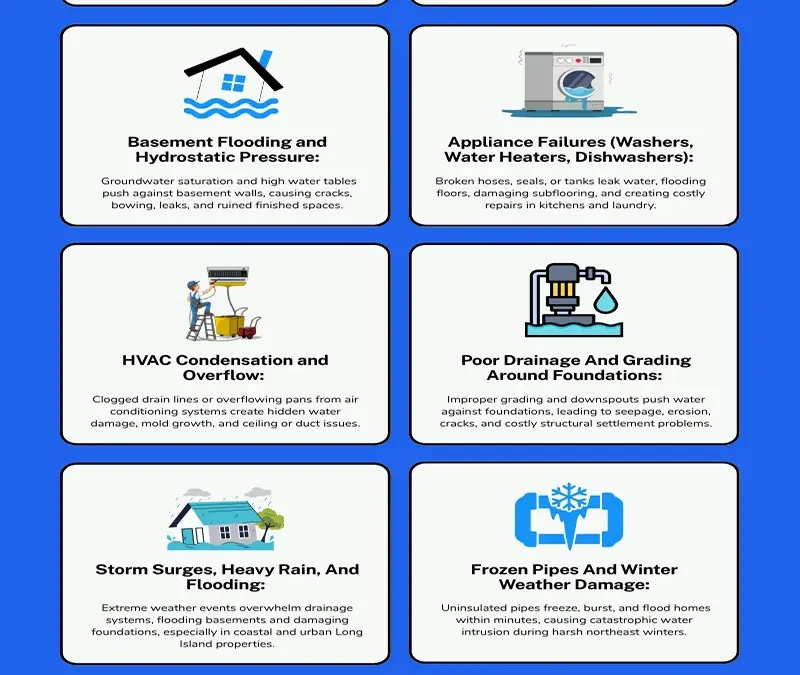Ask any contractor what destroys more homes than fire, and the answer is the same: water. Whether it’s a burst pipe, a clogged gutter, or hydrostatic pressure pressing against a basement wall, water intrusion is relentless. Once it enters a structure, it doesn’t stop until it’s repaired — or until it’s done permanent damage.
National statistics back it up: water damage drives over 20% of all property insurance claims each year, costing billions in repairs. On a local level, we see the same story repeated in Brooklyn brownstones, Queens multifamily units, and Long Island coastal homes — moisture finds a way in, and without prevention, it compromises the structure itself.
In this guide, we’ll walk you through the most common causes of water damage and show you how to stop them before they become major liabilities. From plumbing and roofing to drainage and flooding, we’ll cover the risks, prevention tips, and regional factors you need to know.
Concerned Your Property is At Risk? Book a Free Water Damage Inspection Today.
Understanding the Main Causes of Water Damage
Water damage can stem from many different sources. Plumbing systems, weather events, faulty construction, and environmental conditions all play a role in how moisture enters and spreads inside a building. Each cause has its own risks, but every one of them can be reduced with the right prevention strategies.
Plumbing Leaks And Burst Pipes
Even a small plumbing leak can create big problems when it goes unnoticed. Old pipes, loose fittings, or weakened joints can slowly release water into walls and floors where it damages framing, drywall, and insulation. Sudden pipe bursts, especially during winter freeze cycles, can release hundreds of gallons in just minutes, overwhelming a property and creating conditions for mold and rot. Hidden leaks are just as destructive because they often remain undiscovered until structural repairs are needed.
Water Damage Caused By Plumbing Leaks And Burst Pipes:
- Saturated Drywall And Insulation: Promotes mold growth and poor air quality
- Rotting Wood Framing: Weakens the structural integrity of walls and floors
- Foundation Cracks: Water seepage from plumbing issues undermines concrete
- Flooded Basements: Burst pipes can overwhelm drains and sump systems
- Electrical Hazards: Leaks near wiring increase fire and safety risks
How To Prevent It:
- Inspect Plumbing Regularly: Look for leaks, corrosion, or loose fittings
- Replace Old Pipes And Hoses: Upgrade outdated plumbing before failure occurs
- Insulate Pipes In Unheated Areas: Reduce the risk of freezing and bursting
- Install Leak Detection Systems: Catch small leaks before they spread
- Schedule Annual Maintenance: Have a licensed plumber assess system health
Roof Leaks And Poor Gutter Systems
When a roof is compromised, water has a direct path into the structure. Missing shingles, damaged flashing, and clogged gutters all allow water to penetrate into attics, ceilings, and walls. Heavy New York rainfall and seasonal snowmelt only magnify the risk, turning a small leak into widespread damage. Even minor roof leaks can lead to rotted framing, ruined insulation, and mold growth that spreads quickly through the home.
Water Damage Caused By Roof Leaks And Poor Gutter Systems:
- Attic Moisture And Mold: Damp insulation and wood framing create ideal mold conditions
- Ceiling Stains And Sagging: Leaks weaken drywall and plaster finishes
- Wall And Paint Damage: Water seeps behind siding and interior surfaces
- Structural Wood Rot: Long-term leaks deteriorate rafters and joists
- Basement Seepage: Overflowing gutters force water down foundation walls
How To Prevent It:
- Inspect Roof Annually: Check shingles, flashing, and vulnerable areas
- Clean Gutters And Downspouts: Remove leaves and debris to keep water flowing
- Repair Roof Damage Promptly: Fix small issues before they spread
- Install Gutter Guards: Reduce clogging and overflow risks
- Extend Downspouts: Direct water away from foundations and walls
Basement Flooding And Hydrostatic Pressure
Basements face unique risks because they sit below grade where soil holds water. When the ground becomes saturated, hydrostatic pressure pushes against basement walls and floors. On Long Island, high water tables make this problem especially common. Without proper drainage, the pressure creates cracks, leaks, and even bowing walls. Finished basements are particularly vulnerable since carpeting, drywall, and electrical systems can be destroyed in a single flooding event.
Water Damage Caused By Basement Flooding And Hydrostatic Pressure:
- Wall Cracks And Seepage: Pressurized groundwater forces its way inside
- Bowing Basement Walls: Excessive lateral pressure weakens foundations
- Damaged Flooring And Drywall: Finished basements absorb water quickly
- Mold Growth And Odors: Moisture in hidden areas leads to long-term contamination
- Loss Of Property Value: Persistent basement flooding makes homes harder to sell
How To Prevent It:
- Install Sump Pumps: Remove collected groundwater before it floods
- Add French Drains: Relieve pressure and redirect water away from walls
- Apply Waterproof Coatings: Seal basement walls against seepage
- Maintain Grading Around The Home: Ensure soil slopes away from foundations
- Schedule Regular Inspections: Identify early signs of cracks or water intrusion
Appliance Failures (Washers, Water Heaters, Dishwashers)
Appliances that use water are a frequent source of leaks. Aging hoses, worn-out seals, and water heater tank failures can release large amounts of water in a short time. Because many of these appliances sit in laundry rooms, basements, or utility spaces, leaks often go unnoticed until the damage spreads. Neglected maintenance is one of the most common reasons these failures lead to costly water damage.
Water Damage Caused By Appliance Failures:
- Saturated Floors And Subflooring: Leaks seep into flooring materials and cause long-term deterioration
- Warped Cabinets And Baseboards: Moisture spreads to surrounding wood surfaces and weakens finishes
- Mold Growth In Hidden Areas: Dark, damp spaces behind appliances create ideal conditions for mold colonies
- Water Heater Tank Ruptures: Sudden failures release dozens of gallons, flooding surrounding areas quickly
- Electrical Hazards Near Appliances: Leaks near outlets and wiring increase shock and fire risks
How To Prevent It:
- Replace Hoses Regularly: Upgrade rubber hoses to braided stainless steel for longer life
- Inspect Appliance Seals And Connections: Check for drips or worn-out fittings around washers and dishwashers
- Flush And Maintain Water Heaters: Extend tank life and reduce sediment buildup
- Install Water Alarms Near Appliances: Detect leaks before they cause widespread damage
- Schedule Routine Maintenance: Follow manufacturer guidelines to keep appliances in working condition
HVAC Condensation And Overflow
Heating and cooling systems can cause hidden water damage when condensation pans, coils, or drain lines become clogged. Overflows often go unnoticed until water stains appear on ceilings or ductwork is compromised. Moisture inside HVAC systems not only damages building materials but also spreads mold spores throughout the air system. Many property owners do not realize that HVAC equipment can be one of the main sources of water intrusion.
Water Damage Caused By HVAC Condensation And Overflow:
- Ceiling Stains And Collapse: Overflowing pans saturate drywall and plaster above living spaces
- Mold Inside Ductwork: Damp ducts spread spores and create poor indoor air quality
- Hidden Leaks Behind Walls: Condensate lines drip unnoticed until structural damage occurs
- Rusted HVAC Components: Standing water damages coils and pans, leading to costly repairs
- Electrical Shortages: Moisture exposure compromises HVAC wiring and circuits
How To Prevent It:
- Schedule Seasonal HVAC Inspections: Identify clogs and leaks before they create damage
- Clean Condensate Drain Lines: Keep lines clear to prevent blockages and overflow
- Monitor Drip Pans And Coils: Ensure pans drain properly and coils remain free of buildup
- Install Overflow Shutoff Switches: Automatically stop the system when water accumulates
- Change Filters Regularly: Maintain airflow and reduce condensation inside units
Poor Drainage And Grading Around Foundations
When water is not directed away from a home, it naturally moves toward the foundation. Negative slope around the property, pooling water near walls, or missing downspouts all force moisture into the ground beside the structure. Over time, this leads to seepage, erosion, and even settlement in New York homes. Left unchecked, poor drainage accelerates foundation cracks and costly structural problems.
Water Damage Caused By Poor Drainage And Grading Around Foundations:
- Foundation Seepage: Water collects at the base of walls and seeps inside
- Soil Erosion Around Homes: Grading problems wash away soil supporting foundations
- Structural Settlement: Saturated soils shift and allow uneven foundation sinking
- Basement Leaks: Standing water outside walls finds pathways inside
- Wall Cracks: Pressure from pooling water contributes to foundation cracking
How To Prevent It:
- Re-Grade Soil Around Foundations: Ensure proper slope directs water away from the home
- Extend Downspouts Away From Walls: Move runoff several feet from foundations
- Install French Drains: Relieve pressure and carry water safely away
- Add Catch Basins Or Swales: Collect and redirect pooling water
- Inspect Grading After Heavy Rain: Identify low spots and fix erosion quickly
Storm Surges, Heavy Rain, And Flooding
Extreme weather events bring water intrusion on a much larger scale. Hurricanes, tropical storms, and Nor’easters have caused billions in damages across New York and Long Island. Coastal storm surges and heavy rainfall overwhelm drainage systems and flood basements, destroying mechanical systems and threatening the safety of occupants. Urban neighborhoods face just as much risk, with outdated infrastructure unable to handle the volume of stormwater.
Water Damage Caused By Storm Surges, Heavy Rain, And Flooding:
- Groundwater and stormwater enter through cracks, drains, and windowsBasement Flooding:
- Destroyed Mechanical Systems: Furnaces, boilers, and electrical panels are ruined by floodwater
- Structural Weakening: Foundations and framing deteriorate under prolonged flooding
- Contaminated Interiors: Floodwater carries sewage, debris, and hazardous materials inside
- Long-Term Mold Growth: Saturated materials remain damp long after floodwaters recede
How To Prevent It:
- Install Backup Sump Pumps: Keep basements dry during power outages or heavy rain
- Use Flood Barriers Or Shields: Protect entry points from stormwater and surge levels
- Maintain Drainage Systems: Clear storm drains, gutters, and culverts regularly
- Review Flood Insurance Coverage: Prepare financially for flood-related losses
- Elevate Mechanical Systems: Move furnaces, boilers, and panels above flood-prone levels
Frozen Pipes And Winter Weather Damage
Northeast winters bring significant risk to plumbing systems. When uninsulated pipes freeze, the expanding ice places pressure on pipe walls until they burst. Once thawed, a frozen pipe can release hundreds of gallons in minutes, flooding basements and living areas. Freeze and thaw cycles make this a seasonal risk in New York homes, especially in crawl spaces, attics, and exterior walls without proper insulation.
Water Damage Caused By Frozen Pipes And Winter Weather Damage:
- Burst Plumbing Lines: Frozen water expands and cracks pipes
- Flooded Basements And Living Areas: Sudden bursts release large amounts of water quickly
- Damaged Insulation And Drywall: Leaks saturate walls and ceilings after thawing
- Mold Growth From Standing Water: Damp materials create perfect mold conditions
- Costly Emergency Repairs: Burst pipes require immediate plumbing and water cleanup services
How To Prevent It:
- Insulate Pipes In Vulnerable Areas: Protect crawl spaces, attics, and exterior walls
- Let Faucets Drip During Freezes: Keep water moving to prevent ice buildup
- Seal Cracks And Gaps: Reduce cold air infiltration around pipes
- Heat Crawl Spaces And Basements: Maintain above-freezing temperatures in risk zones
- Shut Off Exterior Spigots: Drain outdoor water lines before winter weather arrives
Sewer Backups And Overflows
Among the most common causes of water damage are sewer backups and overflows. When clogged household lines or municipal systems become overloaded, contaminated water can flow back into basements and living areas. This problem is especially severe in neighborhoods with aging NYC infrastructure, where combined sewer systems are easily overwhelmed during heavy rains. The result is more than just water intrusion: sewage introduces biohazards, costly cleanup, and serious health risks.
Water Damage Caused By Sewer Backups And Overflows:
- Contaminated Interiors: Sewage carries bacteria, chemicals, and pathogens into homes
- Irreversible Property Damage: Flooring, drywall, and furniture are destroyed by blackwater
- Long-Term Mold Infestation: Damp, contaminated materials encourage toxic mold growth
- Structural Deterioration: Persistent moisture weakens walls and foundations
- Expensive Remediation Costs: Specialized cleanup is required for biohazard safety
How To Prevent It:
- Install Backflow Valves: Stop sewage from flowing into the home during overloads
- Schedule Regular Plumbing Maintenance: Inspect and clear main lines before blockages occur
- Avoid Flushing Improper Items: Prevent clogs from wipes, grease, or debris
- Upgrade Old Sewer Connections: Replace deteriorated pipes in older properties
- Consult With Licensed Plumbers: Get professional evaluations of high-risk systems
Construction Defects Or Poor Waterproofing
Faulty construction practices are another of the most common causes of water damage. Improper flashing, missing membranes, or weak concrete can allow water intrusion from the start. Flipped or renovated homes often hide these problems behind cosmetic finishes, leaving new owners with costly repairs. Over time, construction defects and inadequate waterproofing can create damage far more expensive than the original cost of building.
Water Damage Caused By Construction Defects Or Poor Waterproofing:
- Improper Flashing At Roofs And Windows: Allows water to enter through critical junctions
- Missing Or Failed Waterproof Membranes: Leaves basements and walls vulnerable to seepage
- Weak Or Poorly Mixed Concrete: Permits water penetration and structural cracking
- Hidden Defects In Renovated Homes: Cosmetic upgrades disguise underlying water problems
- Accelerated Long-Term Costs: Repairs exceed what proper construction would have required
How To Prevent It:
- Hire Licensed Contractors: Ensure work complies with building codes and best practices
- Insist On Waterproof Materials: Use membranes, sealants, and drainage layers in construction
- Request Warranties And Documentation: Protect against defects hidden during renovation
- Inspect Flipped Properties Carefully: Bring in professionals before closing a purchase
- Address Issues Immediately: Fix small defects before they expand into major failures
Don’t Wait for Costly Repairs! Schedule a Free Water Intrusion Inspection!
Main Causes Of Water Damage In Long Island
The main causes of water damage in Long Island are tied to the region’s soil types, groundwater levels, flood zones, and coastal location. Property owners here face unique risks that make prevention and inspections even more important than in other parts of the country.
- Groundwater Flooding And High Water Tables: Excess water in the soil creates persistent hydrostatic pressure on foundations.
- Coastal Flooding And Storm Surge Risk: Ocean storms and Nor’easters push water into homes and basements.
- Sandy Soils Causing Seepage In Suffolk: Loose soils allow water to move easily through foundations.
- Clay Soils And Settlement Risk In Queens/Nassau: Expansive clays swell and shrink, cracking foundations.
- Urban Infrastructure Failures In NYC Boroughs: Aging storm drains and combined sewers overwhelm easily in heavy rain.
Zavza Seal Specializes In New York’s Toughest Water Intrusion Problems! Book A Free Inspection!
How Zavza Seal Can Help
Water intrusion problems need targeted solutions. Zavza Seal provides comprehensive services that address both the source and the damage.
- Residential Services: Basement waterproofing, drainage systems, sump pump installation, and mold remediation.
- Commercial Services: Site drainage design, foundation waterproofing, and retaining wall relief systems.
- New Construction: Proper grading, advanced waterproofing materials, and full compliance with local building codes.
How To Choose A Reliable Water Damage Contractor
Not all contractors deliver lasting solutions. When evaluating who to hire, avoid companies that offer surface-only fixes. Ask questions that reveal whether they can solve the root of the problem.
Questions To Ask:
- Are you licensed and insured?
- Do you provide moisture testing and diagnostics?
- Do you repair both the cause and the damage, or just surface issues?
- What type of warranty do you offer?
Ask Zavza Seal these questions! We’ll have the right answers.
Why Choose Us For Water Damage Repair In Long Island
When it comes to water damage, quick fixes are not enough. Zavza Seal combines licensed expertise, transparent estimates, and proven results across NYC and Long Island to deliver solutions that last.
- Licensed New York State mold assessors and contractors
- Expertise in water damage, foundation repair, and waterproofing integration
- Transparent estimates and solid warranties
- Proven success in case studies across NYC and Long Island
Most Common Causes Of Water Damage: Final Thoughts
The most common causes of water damage often start small but can grow into major structural and health hazards. Identifying and addressing problems early saves property owners from expensive repairs and keeps homes and buildings safe. Water damage prevention is always more cost-effective than restoration after damage has occurred.
Zavza Seal has built a reputation for solving water intrusion issues nationally, with unmatched expertise in New York and Long Island.
Don’t Let Water Damage Spread! Schedule a Free Risk Assessment With Zavza Seal Today.
Frequently Asked Questions About the Causes of Water Damage
What Are The Most Common Causes Of Water Damage In Homes?
Plumbing leaks, roof failures, basement flooding, poor drainage, and appliance malfunctions are among the most common causes of water damage in homes.
Can Poor Drainage Cause Water Damage?
Yes. Improper grading and clogged gutters push water against foundations, leading to seepage, cracks, and structural settlement.
How Do I Know If Water Damage Is Serious?
Look for spreading stains, peeling paint, persistent odors, mold growth, or cracks in foundations. These signs signal deeper problems.
How Can I Prevent Basement Water Damage?
Install sump pumps, use French drains, apply waterproof coatings, and ensure proper grading around the property.
Does Insurance Cover Water Damage?
Most policies cover sudden damage like burst pipes but exclude flooding. Review your policy and consider flood insurance in high-risk zones.
How Does Water Damage Affect Foundations?
Water weakens concrete, causes cracks, and increases hydrostatic pressure, which can lead to settlement or bowing walls.
What Are Signs Of Hidden Water Damage?
Musty odors, warped flooring, peeling paint, or unexplained increases in water bills often indicate hidden leaks.
Can Water Damage Cause Mold?
Yes. Mold growth can begin within 24–48 hours of moisture exposure, spreading quickly through walls, ceilings, and HVAC systems.
How Do You Fix Water Damage Quickly?
Stop the source, dry the affected area, and call professionals for remediation. Fast action prevents secondary mold or structural damage.
How Much Does Water Damage Repair Cost?
Costs vary widely, from minor fixes under $1,000 to major structural repairs exceeding $20,000, depending on severity and cause.








